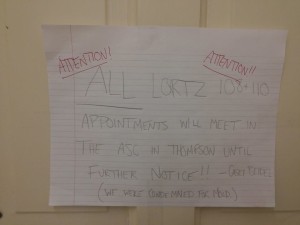Mold Creeps into Lortz Hall: Over 65 Times Allowable Levels
 Sept. 17, 2014, room 105 in Lortz Hall was shut down due to concerns of a possible mold infestation. Inspectors arrived the following day to take air samples which, showing a high spore count, eventually resulted in the closing of the lower north wing on Oct. 1, 2014.
Sept. 17, 2014, room 105 in Lortz Hall was shut down due to concerns of a possible mold infestation. Inspectors arrived the following day to take air samples which, showing a high spore count, eventually resulted in the closing of the lower north wing on Oct. 1, 2014.
Staff members working in the writing center, one of the affected sections, and students were informed of the situation when an all-campus email was sent out on Oct. 2, 2014. The Baxter Group oversaw the remediation process, which took seven days to complete.
Staff and students were allowed back into some of the restricted areas on Oct. 16, 2014.
The air-conditioning units, which were pulling moist air from the outside, were the cause of the mold infestation. The units were pulling in warm air from outside instead of circulating air within the building, increasing humidity and creating an ideal environment for the rapid spread of mold in the lower wing.
Lortz 105’s mold count was reduced from 49,000 to 27 and Lortz 108’s mold count was reduced from 25,000 to zero. The standard for Penicillium/Aspergillus (mold) spores is 750 spores per cubic meter according to a summary report sent by Chuck Naso, Environmental Health and Safety Compliance Manager.
The other affected rooms on the bottom floor are still closed to occupants, because the rooms require scraping and repainting prior to use. Mold counts in all rooms reduced to below 160 spores per cubic meter.
A proposal is in the draft stages for the implementation of dehumidifiers for the downstairs of Lortz and a new response system is in the works to handle the communication of any future environmental concerns.
Patrick Fox contributed to this report.
